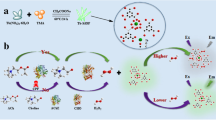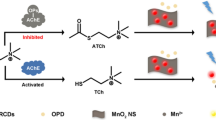Abstract
Ti3C2 MQDs were synthesized using an effective fluorine-free method with excitation/emission maxima at 390/490 nm and a fluorescence quantum yield of 11.78%. In contrast to the traditional, hazardous, and time-consuming process of HF pretreatment, our fluorine-free method is safe and simple. Acetylcholinesterase (AChE) could catalyze the hydrolysis of acetylthiocholine (ATCh) to produce thiocholine which was further reacted with Ehrman’s reagent and decomposed to form a yellow product 2-nitro-5-thiobenate anion (TNB). Due to the obvious overlap between the excitation spectrum of Ti3C2 MQDs and the absorption spectrum of TNB, AChE catalyzed the hydrolysis of substrate DTNB/ATCh to form TNB, which can effectively quench the fluorescence of Ti3C2 MQDs through the inner filter effect (IFE). However, the presence of organophosphorus (OPs) inhibited the activity of AChE, leading to a less expressed IFE and increasing recovery of fluorescence. This was used for the quantification of OPs with a detection limit of 0.20 μg·L−1. Moreover, with the constant increase of AChE activity, the color of the reaction system changed visibly from colorless to yellow, and then from yellow to colorless with further continuous addition of OPs. A colorimetric detection with a paper-based sensor of AChE activity and OP concentration was also fabricated by analyzing changes in RGB value using a smartphone APP. In this work, we proposed an effective fluorescence/colorimetric two-mode detection method, which opened a new horizon to detect other targets.
Graphical abstract







Similar content being viewed by others
References
Sidhu GK, Singh S, Kumar V, Dhanjal DS, Datta S, Singh J (2019) Toxicity, monitoring and biodegradation of organophosphate pesticides: a review. Crit Rev Environ Sci Technol 49:1135–1187. https://doi.org/10.1021/ac9002722
Liu D, Chen W, Wei J, Li X, Wang Z, Jiang X (2012) A highly sensitive, dual-readout assay based on gold nanoparticles for organophosphorus and carbamate pesticides. Anal Chem 84:4185–4191. https://doi.org/10.1021/ac300545p
Wang M, Gu X, Zhang G, Zhang D, Zhu D (2009) Convenient and continuous fluorometric assay method for acetylcholinesterase and inhibitor screening based on the aggregation-induced emission. Anal Chem 81:4444–4449. https://doi.org/10.1021/ac9002722
Chen J, Liao D, Wang Y, Zhou H, Li W, Yu C (2013) Real-time fluorometric assay for acetylcholinesterase activity and inhibitor screening through the pyrene probe monomer–excimer transition. Org Lett 15:2132–2135. https://doi.org/10.1021/ol400619t
Sun J, Yang X (2015) Gold nanoclusters–Cu2+ ensemble-based fluorescence turn-on and real-time assay for acetylcholinesterase activity and inhibitor screening. Biosens Bioelectron 74:177–182. https://doi.org/10.1016/j.bios.2015.06.013
Su YS, Jen JF (2010) Determination of organophosphorous pesticides in water using in-syringe ultrasound-assisted emulsification and gas chromatography with electron-capture detection. J Chromatogr A 1217:5043–5049. https://doi.org/10.1016/j.chroma.2010.06.006
Talaee M, Lorestani B, Ramezani M, Cheraghi M, Jamehbozorgi S (2019) Microfunnel-filter-based emulsification microextraction followed by gas chromatography for simple determination of organophosphorus pesticides in environmental water samples. J Sep Sci 42:2418–2425. https://doi.org/10.1002/jssc.201900132
He L, Luo X, Jiang X, Qu L (2010) A new 1,3-dibutylimidazolium hexafluorophosphate ionic liquid-based dispersive liquid–liquid microextraction to determine organophosphorus pesticides in water and fruit samples by high-performance liquid chromatography. J Chromatogr A 1217:5013–5020. https://doi.org/10.1016/j.chroma.2010.05.057
Huang G, Ouyang J, Baeyens WRG, Yang Y, Tao C (2002) High-performance liquid chromatographic assay of dichlorvos, isocarbophos and methyl parathion from plant leaves using chemiluminescence detection. Anal Chim Acta 474:21–29. https://doi.org/10.1016/S0003-2670(02)01014-0
Du D, Wang J, Wang L, Lu D, Lin Y (2012) Integrated lateral flow test strip with electrochemical sensor for quantification of phosphorylated cholinesterase: biomarker of exposure to organophosphorus agents. Anal Chem 84:1380–1385. https://doi.org/10.1021/ac202391w
Yang Q, Li Q, Li H, Li F (2021) pH-response quantum dots with orange–red emission for monitoring the residue, distribution, and variation of an organophosphorus pesticide in an agricultural crop. J Agric Food Chem 69:2689–2696. https://doi.org/10.1021/acs.jafc.0c08212
Li Y, Chen S, Lin D, Chen Z, Qiu P (2020) A dual-mode nanoprobe for the determination of parathion methyl based on graphene quantum dots modified silver nanoparticles. Anal Bioanal Chem 412:5583–5591. https://doi.org/10.1007/s00216-020-02773-8
Suo Z, Liu X, Hou X, Liu Y, Lu J, Xing F, Chen Y, Feng L (2020) Ratiometric assays for acetylcholinesterase activity and organo-phosphorous pesticide based on superior carbon quantum dots and blgf-protected gold nanoclusters fret process. ChemistrySelect 5:9254–9260. https://doi.org/10.1002/slct.202002042
Li Y, Shao H, Lin Z, Lu J, Liu L, Duployer B, Persson POÅ, Eklund P, Hultman L, Li M, Chen K, Zha XH, Du S, Rozier P, Chai Z, Raymundo-Piñero E, Taberna PL, Simon P, Huang Q (2020) A general lewis acidic etching route for preparing mxenes with enhanced electrochemical performance in non-aqueous electrolyte. Nat Mater 19:894–899. https://doi.org/10.1038/s41563-020-0657-0
Lu S, Sui L, Liu Y, Yong X, Xiao G, Yuan K, Liu Z, Liu B, Zou B, Yang B (2019) White photoluminescent Ti3C2 MXene quantum dots with two-photon fluorescence. Adv Sci 6:1801470. https://doi.org/10.1002/advs.201801470
Xu Q, Ding L, Wen Y, Yang W, Zhou H, Chen X, Street J, Zhou A, Ong WJ, Li N (2018) High photoluminescence quantum yield of 18.7% by using nitrogen-doped Ti3C2 MXene quantum dots. J Mater Chem C 6:6360–6369. https://doi.org/10.1039/C8TC02156B
Guan Q, Ma J, Yang W, Zhang R, Zhang X, Dong X, Fan Y, Cai L, Cao Y, Zhang Y, Li N, Xu Q (2019) Highly fluorescent Ti3C2 MXene quantum dots for macrophage labeling and Cu2+ ion sensing. Nanoscale 11:14123–14133. https://doi.org/10.1039/C9NR04421C
Chen X, Sun X, Xu W, Pan G, Zhou D, Zhu J, Wang H, Bai X, Dong B, Song H (2018) Ratiometric photoluminescence sensing based on Ti3C2 MXene quantum dots as an intracellular pH sensor. Nanoscale 10:1111–1118. https://doi.org/10.1039/C7NR06958H
Zhu X, Pang X, Zhang Y, Yao S (2019) Titanium carbide MXenes combined with red-emitting carbon dots as a unique turn-on fluorescent nanosensor for label-free determination of glucose. J Mater Chem B 7:7729–7735. https://doi.org/10.1039/C9TB02060H
Pandey P, Sengupta A, Parmar S, Bansode U, Gosavi S, Swarnkar A, Muduli S, Mohite AD, Ogale S (2020) CsPbBr 3–Ti3C2Tx MXene QD/QD heterojunction: photoluminescence quenching, charge transfer, and Cd ion sensing application. ACS Appl Nano Mater 3:3305–3314. https://doi.org/10.1021/acsanm.0c00051
Xu X, Zhang H, Diao Q, Zhu Y, Yang G, Ma B (2020) Highly sensitive fluorescent sensing for intracellular glutathione based on Ti3C2 quantum dots. J Mater Sci Mater Electron 31:175–181. https://doi.org/10.1007/s10854-019-02682-2
Zhang Q, Sun Y, Liu M, Liu Y (2020) Selective detection of Fe3+ ions based on fluorescence MXene quantum dots via a mechanism integrating electron transfer and inner filter effect. Nanoscale 12:1826–1832. https://doi.org/10.1039/C9NR08794J
Guo Z, Zhu X, Wang S, Lei C, Huang Y, Nie Z, Yao S (2018) Fluorescent Ti3C2 MXene quantum dots for an alkaline phosphatase assay and embryonic stem cell identification based on the inner filter effect. Nanoscale 10:19579–19585. https://doi.org/10.1039/C8NR05767B
Liu M, Bai Y, He Y, Zhou J, Ge Y, Zhou J, Song G (2021) Facile microwave-assisted synthesis of Ti3C2 MXene quantum dots for ratiometric fluorescence detection of hypochlorite. Microchim Acta 188:15. https://doi.org/10.1007/s00604-020-04655-3
Liu M, He Y, Zhou J, Ge Y, Zhou J, Song G (2020) A ’’naked-eye’’ colorimetric and ratiometric fluorescence probe for uric acid based on Ti3C2 MXene quantum dots. Anal Chim Acta 1103:134–142. https://doi.org/10.1016/j.aca.2019.12.069
Xue Q, Zhang H, Zhu M, Pei Z, Li H, Wang Z, Huang Y, Huang Y, Deng Q, Zhou J, Du S, Huang Q, Zhi C (2017) Photoluminescent Ti3C2 MXene quantum dots for multicolor cellular imaging. Adv Mater 29:1604847. https://doi.org/10.1002/adma.201604847
Yang M, Liu M, Wu Z, He Y, Ge Y, Song G, Zhou J (2019) Carbon dots co-doped with nitrogen and chlorine for “off-on” fluorometric determination of the activity of acetylcholinesterase and for quantification of organophosphate pesticides. Microchim Acta 186:585. https://doi.org/10.1007/s00604-019-3715-z
Yu X, Cai X, Cui H, Lee SW, Yu XF, Liu B (2017) Fluorine-free preparation of titanium carbide MXene quantum dots with high near-infrared photothermal performances for cancer therapy. Nanoscale 9:17859–17864. https://doi.org/10.1039/C7NR05997C
Xu X, Cen Y, Xu G, Wei F, Shi M, Hu Q (2019) A ratiometric fluorescence probe based on carbon dots for discriminative and highly sensitive detection of acetylcholinesterase and butyrylcholinesterase in human whole blood. Biosens Bioelectron 131:232–236. https://doi.org/10.1016/j.bios.2019.02.031
Ye M, Lin B, Yu Y, Li H, Wang Y, Zhang L, Cao Y, Guo M (2020) A ratiometric fluorescence probe based on graphene quantum dots and o-phenylenediamine for highly sensitive detection of acetylcholinesterase activity. Microchim Acta 187:511. https://doi.org/10.1007/s00604-020-04522-1
Liu R, Duan S, Bao L, Wu Z, Zhou J, Yu R (2020) Photonic crystal enhanced gold-silver nanoclusters fluorescent sensor for Hg2+ ion. Anal Chim Acta 1114:50–57. https://doi.org/10.1016/j.aca.2020.04.011
Li Y, Kang Z, Kong L, Shi H, Zhang Y, Cui M, Yang DP (2019) MXene- Ti3C2/CuS nanocomposites: enhanced peroxidase-like activity and sensitive colorimetric cholesterol detection. Mater Sci Eng C 104:110000. https://doi.org/10.1016/j.msec.2019.110000
Wu X, Chen T, Chen Y, Yang G (2020) Modified Ti3C2 nanosheets as peroxidase mimetics for use in colorimetric detection and immunoassays. J Mater Chem B 8:2650–2659. https://doi.org/10.1039/D0TB00239A
Li H, Wen Y, Zhu X, Wang J, Zhang L, Sun B (2020) Novel heterostructure of a MXene@NiFe-LDH nanohybrid with superior peroxidase-like activity for sensitive colorimetric detection of glutathione. ACS Sustain Chem Eng 8:520–526. https://doi.org/10.1021/acssuschemeng.9b05987
Liu G, Zou J, Tang Q, Yang X, Zhang Y, Zhang Q, Huang W, Chen P, Shao J, Dong X (2017) Surface modified Ti3C2 MXene nanosheets for tumor targeting photothermal/photodynamic/chemo synergistic therapy. ACS Appl Mater Interfaces 9:40077–40086. https://doi.org/10.1021/acsami.7b13421
Liu M, Zhou J, He Y, Cai Z, Ge Y, Zhou J, Song G (2019) ε-poly-l-lysine-protected Ti3C2 MXene quantum dots with high quantum yield for fluorometric determination of cytochrome c and trypsin. Microchim Acta 186:770. https://doi.org/10.1007/s00604-019-3945-0
Wang T, Zeng LH, Li DL (2017) A review on the methods for correcting the fluorescence inner-filter effect of fluorescence spectrum. Appl Spectrosc Rev 52:883–908. https://doi.org/10.1080/05704928.2017.1345758
Acknowledgements
This work was financially supported by the National Natural Science Foundation of China (21707030) and the Open Project Funding of the State Key Laboratory of Biocatalysis and Enzyme Engineering (SKLBEE2020017).
Author information
Authors and Affiliations
Corresponding author
Ethics declarations
Conflict of interest
The authors declare no competing interests.
Additional information
Publisher's note
Springer Nature remains neutral with regard to jurisdictional claims in published maps and institutional affiliations.
Supplementary Information
Below is the link to the electronic supplementary material.
Rights and permissions
About this article
Cite this article
Pei, T., He, Y., Wang, Y. et al. Fluorine-free synthesis of Ti3C2 MQDs for smartphone-based fluorescent and colorimetric determination of acetylcholinesterase and organophosphorus pesticides. Microchim Acta 189, 7 (2022). https://doi.org/10.1007/s00604-021-05115-2
Received:
Accepted:
Published:
DOI: https://doi.org/10.1007/s00604-021-05115-2




